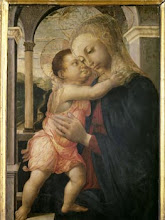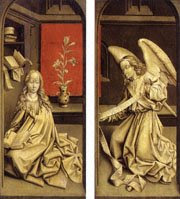sabato
venerdì
Goya Lucientes, Francisco de...














GOYA Y LUCIENTES, Francisco de
(b. 1746, Fuendetodos, d. 1828, Bordeaux)
Biography
Spanish painter (full name: Francisco José de Goya y Lucientes) and graphic artist. He was the most powerful and original European artist of his time, but his genius was slow in maturing and he was well into his thirties before he began producing work that set him apart from his contemporaries. Born at Fuendetodos in Aragon, the son of a gilder, he served his apprenticeship at Saragossa, then appears to have worked at Madrid for the court painter Francisco Bayeu. In about 1770 he went to Italy but he was back in Saragossa the next year.
In 1773 he married Bayeu's sister, and by 1775 had settled at Madrid. Bayeu secured him employment making cartoons for the royal tapestry factory, and this took up most of his working time from 1775 to 1792. He made sixty-three cartoons (Prado, Madrid), the largest more than 6 m. wide. The subjects range from idyllic scenes to realistic incidents of everyday life, conceived throughout in a gay and romantic spirit and executed with Rococo decorative charm. During these years Goya also found time for portraits and religious works, and his status grew. He was elected to the Academy of San Fernando in 1780 and became assistant director of painting in 1785. In 1789 he was nominated a court painter to the new king, Charles IV.
A more important turning-point in his career than any of these appointments, however, was the mysterious and traumatic illness he experienced in 1792. It left him stone deaf, and while convalescing in 1793 he painted a series of small pictures of 'fantasy and invention' in order, as he said, 'to occupy an imagination mortified by the contemplation of my sufferings'. This marks the beginning of his preoccupation with the morbid, bizarre, and menacing that was to be such a feature of his mature work. It was given vivid expression in the first of his great series of engravings, Los Caprichos (Caprices), issued in 1799. The set (executed c. 1793-98) consists of eighty-two plates in etching reinforced with aquatint, and their humour is constantly overshadowed by an element of nightmare. Technically revealing the influence of Rembrandt, they feature savagely satirical attacks on social customs and abuses of the Church, with elements of the macabre in scenes of witchcraft and diabolism.
In 1795 Goya succeeded Bayeu as director of painting at the Academy of San Fernando and in 1799 he was appointed First Court Painter, producing his most famous portrait group, the Family of Charles IV (Prado), in the following year. The weaknesses of the royal family are revealed with unsparing realism, though evidently without deliberate satirical intent. Goya's early portraits had followed the manner of Mengs, but stimulated by the study of Velázquez's paintings in the royal collection he had developed a much more natural, lively, and personal style, showing increasing mastery of pose and expression, heightened by dramatic contrasts of light and shade. From about the same date as the royal group portrait are the celebrated pair of paintings the Clothed Maja and Naked Maja (Prado), whose erotic nature led Goya to be summoned before the Inquisition. Popular legend has it that they represent the Duchess of Alba, the beautiful widow whose relationship with Goya caused scandal in Madrid.
Goya retained his appointment of court painter under Joseph Buonaparte during the French occupation of Spain (1808-14), but his activity as a painter of court and society decreased, and he was torn between his welcome for the regime as a liberal and his abhorrence as a patriot against foreign military rule. After the restoration of Ferdinand VII in 1814 Goya was exonerated from the charge of having 'accepted employment from the usurper' by claiming he had not worn the medal awarded him by the French, and he painted for the king the two famous scenes of the bloody uprising of the citizens of Madrid against the occupying forces - The Second of May, 1808 and The Third of May, 1808 (Prado). Equally dramatic, and even more savage and macabre, are the sixty-five etchings Los Desastres de la Guerra (The Disasters of War, 1810-14) - nightmare scenes, depicting atrocities committed by both French and Spanish.
Goya virtually retired from public life after 1815, working for himself and friends. He kept the title of court painter but was superseded in royal favour by Vicente López. Towards the end of 1819 he fell seriously ill for the second time (a remarkable self-portrait in the Minneapolis Institute of Arts shows him with the doctor who nursed him). He had just bought a country house in the outskirts of Madrid, the Quinta del Sordo (House of the Deaf Man); and it was here after his recovery in 1820 that he executed fourteen large murals, sometimes known as the Black Paintings, now in the Prado. Painted almost entirely in blacks, greys, and browns, they depict horrific scenes, such as Saturn Devouring One of His Sons, executed with an almost ferocious intensity and freedom of handling.
In 1824 Goya obtained permission from Ferdinand VII to leave the country for reasons of health and settled at Bordeaux. He made two brief visits to Spain, on the first of which (1826) he officially resigned as court painter. In these last years he took up the new medium of lithography (in his series the Bulls of Bordeaux), while his paintings illustrate his progress towards a style which foreshadowed that of the Impressionists.
Goya completed some 500 oil paintings and murals, about 300 etchings and lithographs, and many hundreds of drawings. He was exceptionally versatile and his work expresses a very wide range of emotion. His technical freedom and originality likewise are remarkable — his frescoes in San Antonio de la Florida in Madrid (1798). for example, were evidently executed with sponges. In his own day he was chiefly celebrated for his portraits, of which he painted more than 200; but his fame now rests equally on his other work.
Spanish painter (b. 1746, Fuendetodos, d. 1828, Bordeaux)
Paintings before 1781
Paintings between 1781 and 1790
Paintings between 1791 and 1795
Paintings between 1796 and 1800
Paintings between 1801 and 1805
Paintings between 1806 and 1810
Paintings between 1811 and 1815
Paintings between 1816 and 1828
"Black Paintings" in the Quinta del Sordo (1820-1823)
Graphic works
Paintings before 1781
Paintings between 1781 and 1790
Paintings between 1791 and 1795
Paintings between 1796 and 1800
Paintings between 1801 and 1805
Paintings between 1806 and 1810
Paintings between 1811 and 1815
Paintings between 1816 and 1828
"Black Paintings" in the Quinta del Sordo (1820-1823)
Graphic works
:: Francisco Goya...












Francisco GOYA naît le 30 mars 1746, à Fuendetodos, près de Saragosse, il est le fils de José Goya, maître-doreur et de Gracia Lucientes. Vers 1760, Goya étudie la peinture à Saragosse chez José Luzan.
A Madrid en 1763, il se présente au concours de l'Académie, auquel il échoue. En 1766, il échoue au concours triennal de l'Académie de Madrid.Entre 1767 et 1770, Goya quitte Madrid pour la France, puis l'Italie. Il est à Rome en 1771. En avril, il participe au concours de peinture de l'Académie de Parme ; il obtient six voix mais pas de prix. Il rentre en juin à Saragosse.En 1771, Goya part pour l'Italie, où il reste environ une année. Il passe quelques mois à Rome et prend part au concours de l'académie de Parme, qu'il réussit (Annibal passant les Alpes, 1771). De retour en Espagne, il commence à réaliser une série de gravures à partir de tableaux de Vélasquez, qui est, avec Rembrandt, son modèle.En juillet 1773, Francisco Goya épouse Josefa Bayeu, la sœur de Francisco Bayeu. Il s'installe à Madrid.En 1775, Bayeu procure à Goya une importante commande : des cartons pour la Manufacture Royale de Santa Barbara.En 1780, Goya est nommé académicien de mérite à l'Académie de San Fernando ; ses relations avec son beau-frère Bayeu se détériorent. José Goya, le père de l'artiste, meurt en 1781. Le 2 décembre 1784, Josefa donne naissance à un garçon, Francisco-Javier. En 1785, Goya fait la connaissance du marquis et de la marquise de Penafiel. Le 4 mai 1785, Goya est nommé directeur adjoint de la peinture à l'Académie de San Fernando. Le 25 juin 1786, Goya est nommé peintre du Roi d'Espagne. Le 30 avril 1789, Goya est nommé peintre du roi d'Espagne, par Carlos IV .Mais en 1790, Goya est éloigné de la cour, où il perd ses protecteurs. A l'automne 1792, il voyage à Cadix où il tombe gravement malade et paralysé. Après plusieurs mois de maladie, Goya se remet, mais reste affaibli physiquement et complètement sourd. Son beau-frère Francisco Bayeur meurt en 1795. Goya est nommé directeur de la peinture à l'académie de San Fernando à Madrid. En 1796-1797, on prête à Goya une liaison avec Maria-Cayetana, duchesse d'Albe.En 1797, Goya abandonne sa charge de directeur de la peinture à l'académie de San Fernando, pour raisons de santé. Il commence à graver les " Caprices " (" Los Caprichos ").Entre août et novembre 1798, Goya peint la coupole de la chapelle royale de San Antonio de la Florida.En février 1799, Goya publie le recueil des " Caprices " : les eaux-fortes sont retirées de la vente après quelques jours. Goya est nommé premier peintre de la Cour d'Espagne..Goya peint de nombreux portraits , comme celui de la Famille de Charles IV en 1800, qui confine à la caricature et montre la famille royale sans la moindre idéalisation. Ses portraits doivent beaucoup à la spontanéité, car ils sont sans préparation ni étude,El Pescadoret (coll. Thyssen - Bornemisza, Madrid), La marquise de Santiago (J. Paul Getty Museum), Manuel Osorio de Zuñiga (Metropolitan Museum of Art), Jeune femme avec une mantille (National Gallery of Art de Washington DC), La porteuse d'eau (Budapest Muséum) La duchesse d'Abrantés (Musée du Prado) ou le portrait d'Antonia Zarate (National Gallery of Ireland). L'invasion de l'Espagne par les armées de Napoléon en 1808 et la guerre qui s'ensuit lui inspirent deux puissants chefs-d'œuvre," 2 mai à la Puerta del Sol (Dos de Mayo) et les Fusillades du 3 mai (Tres de Mayo), achevés en 1814 et conservés au musée du Prado : Goya y dénonce avec fougue la violence du conflit, ses répressions sanglantes et le martyre du peuple espagnol. Dans ces deux tableaux, comme dans ses toiles postérieures, Goya peint par touches épaisses de couleurs sombres, illuminées de jaune brillant et rehaussées de rouge."Dans les Désastres de la guerre", série gravée en 1810, il fixe également sa vision désespérée de ces événements et de l'humanité. En 1819, Goya vit avec Leocadia Weiss, une jeune veuve, parente de sa belle-fille, et sa fille Rosario. Le 24 juin 1824, Goya arrive à Bordeaux. Il séjourne à Paris en juillet et, en septembre, s'installe à Bordeaux avec Léocadia Weiss, et sa fille Rosario. En 1826, Goya effectue un court séjour à Madrid, où il revoit Francisco-Javier, âgé de 42 ans, le seul de ses fils qui ait survécu. Goya meurt à Bordeaux le 16 avril 1828.
" La manière d'étaler la couleur, les effets dramatiques et l'emploi de la lumière rappellent le Baroque mais par son esprit , l' œuvre de Goya appartient tout entière au XIXe siècle. Non seulement ses thèmes sont audacieux , inédits, mais certains aspects de sa technique picturale le sont tout autant. On en voit la preuve dans les peintures monochromes, fantastiques dont il s'entoure vers la fin de sa vie, et encore dans son œuvre célèbre, "le 3 mai 1808", où les condamnés tombent sous le feu du peloton d'exécution, non plus au nom d'une justice divine, mais au nom de la liberté..."(C.Wentinck)
Iscriviti a:
Post (Atom)
























.jpg)

.jpg)










